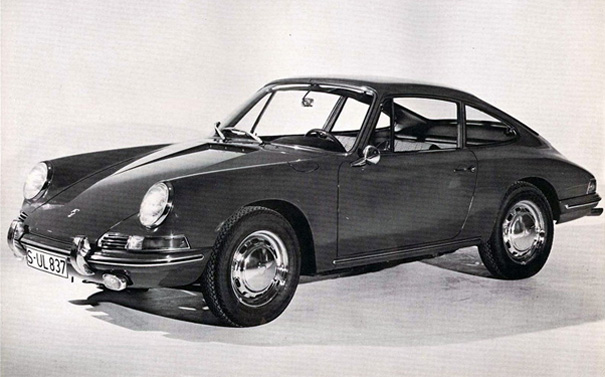The Porker Sow's Ear becomes a Porsche Silk Purse

Depending on who is telling the story, the first Porsche 911 examples that hit the road were either lethal or at least, severely compromised. It was unthinkable that the Type 901 as presented at the Frankfurt Motor Show in September 1963, still carrying Porsche’s internal development code, could ever achieve a fraction of its competition and sales success. Few models can match the almost 50 years of uninterrupted 911 production. Even fewer have so successfully retained a mechanical layout that seemed as futile and flawed as the Porsche 911’s when it first went into production in August 1964.
Type 901 was not defined by the loftiest of engineering principles. Just as Peugeot’s hold over three digit model codes with a centre zero dictated a last minute switch to 911, Porsche had to sacrifice engineering purity for market pragmatism. Porsche’s internal coding of parts stayed with Type 901.
It had to be a four seater but not a shadow of the Mercedes-Benz range thus dimensions and weight were pegged to those of a two seater.
Luggage space big enough to carry golf clubs was a non-negotiable priority as wealthy enthusiast drivers of 1963 indulged in both. Because ride comfort and handling were important, 901 suspension engineering had to achieve both in equal measure.
High performance was also a given. The 901 had to match the performance of the complex 2-litre Carrera quad cam version of the 356’s flat-four with the quietness and docility of the entry level Porsche 356.
Grease nipples were to be eliminated and maintenance reduced to a minimum. Ironically, these priorities would leave a huge margin for competition development ultimately transforming the final result into a legend but not without initial headaches!

The Platform
It is staggering that most of the 911 was defined as early as 1959, the year that several Type 7 prototypes were created around the above priorities. For the 1959 Type 754, the nose, front suspension and rear styling were close to the final production car. However, its Carrera 2 quad-cam four cylinder engine, the 356 swing axle rear suspension and the longer 2400mm/94.5 inch wheelbase would be shelved.
After a later shift in priorities defined the Type 901 as an occasional four seater, the Type 754’s taller roofline went and the wheelbase was cut to 2211mm/87.0in, less than an E-type Jaguar and just 111mm/4.4in longer than the 356. It was boosted to mainly generate an improvement in ride. Overall width was even slimmer than the 356 yet cabin width increased after the 356’s old school body overhang was cut.
The ride and handling priorities presented the biggest headaches. Porsche had already been experimenting with front struts, cleverly using longitudinal torsion bars under the luggage area, instead of coil springs inside the strut towers. Bolted in the same axis as the pivot points of the lower wishbones, the Porsche torsion bars allowed for an unusually deep and wide front luggage compartment.
The Porsche steering rack was mounted rear of the front wheel centres. By employing an underdash dogleg shaft to connect its unusual center pinion with the steering wheel, Porsche freed the luggage compartment of any steering column intrusion. It also made it much easier to build left and right hand drive versions. Almost a decade before safety regulations caught up, this Porsche design had already virtually eliminated steering column intrusion in a crash as there was no steering column as such.
Defining a new independent rear suspension was not as straightforward yet the 356’s swing axles were way past their use-by date. After Porsche refined the space-saving semi-trailing arm design into an almost full trailing-arm system with double-jointed drive shafts, it dodged the often nasty and unwanted camber and castor changes that normally come with this design.

Separate rear wheel hubs with long locating arms pivoting at the centre allowed long suspension travel with minimal geometry changes. Transverse torsion bars located under the floor, minimised intrusion in the rear passenger area. Although the camber and toe-in adjustments were part of the everyday practicality brief, they would later allow the rear end to be set up for different wheel and tyre sizes as well as ride heights. Current tyre technology dictated 165HR15 radial tyres on 4 1/2 inch rims, again similar to an E-type.
Structurally, the unitary 911 bodyshell marked a major step away from the VW-type platform chassis of earlier designs. Its strength was in its floorpan, big box section sills and roof. At the front, the inner guards and front cross member defined its structure, at the rear, it was the box section that supported the engine and rear suspension. Within those self-supporting parameters, there was room to cut weight for racing.
There were two factors that brought this engineering undone. The lack of adjustability in the early front suspension meant that even if prototypes were perfect, only the slightest production variations made later cars unpredictable and potentially lethal. Because the flat six was slightly heavier than intended, the weight distribution was 41.5:58.5, front to rear.
For straight line stability, the suspension had to be tuned with a tendency to understeer to balance the weight at the rear. The short wheelbase and overhanging rear engine could then induce a pendulum effect if a driver backed-off mid-corner for snap oversteer. As an intermediate solution, cast iron weights were first disguised as over riders then mounted behind the front bumper extremities to delay this transition.
Under Ferdinand Piech, the longer term solution involved major tweaks to the suspension and a vital boost in wheelbase for the 1969 model year. An extra 57mm/2.2in boosted the wheelbase to 2268mm/89.3 in. By moving only the rear wheels rearwards and letting the driveshafts take up the extra wheelbase inserted ahead of the rear wheel arch, the combination of a reduction in engine weight and the slight forward shift in drivetrain location, redefined weight distribution at 43:57. It was enough to lift the 911 platform into another league.

The Engine
The first Type 901 flat-six was a 2-litre pushrod design developed from the four as Porsche and its dealers were wary about timing chains and not yet convinced about toothed rubber belts. Although the lift in refinement was a given, the big worry was the increase in valve train noise in an air-cooled flat-six. The design was scrapped and an all new chain-driven overhead cam design became the priority.
The 901’s extra grip, performance and the flat six configuration all combined to make oil surge a major factor, so a dry-sumped design was specified from the start. Ease of service whilst installed in a road car was a priority.
The other major development was the move away from the old fashioned radial-flow cooling fan inherited from Volkswagen. Apart from taking up extra space, the VW design pumped more air in one direction than another. For the new Porsche engine, having to counter this tendency to ensure that both cylinder banks were cooled equally was no longer acceptable. Porsche’s new axial-flow fan for this engine remained a constant right throughout 911 engine evolution as it did the job so much more efficiently and evenly.
The fully counterweighted crankshaft had seven main bearings plus an extra support bush for the crankshaft nose hence the enormous bottom end strength. The initial crankcase was aluminium. Flat spots generated by the early twin triple-choke Solex carburetors were never fully solved and were finally replaced by Webers in 1966.
The big news late in 1966 was the addition of the 911S with its raised compression, extra overlap in the cam timing, bigger valves and ports, upgraded Webers and exhaust tweaks pushing power from the initial 130bhp/97kW to 160bhp/119kW.Torque went up as did the rev limit while fuel consumption stayed the same. The 911 was on its way.
Another critical piece in the early small bumper 911 jigsaw was the replacement of the four-cylinder 912 with the 911T or Touring later in 1967. The big cuts in power (down to 110bhp/82kW) and cost also allowed a significant drop in weight. The base 911 was re-launched as the 911L with the 130bhp/97kW engine.
A switch to fuel injection in July 1968 in the upper levels allowed the carburetor 911T base level to pick up the new injection fuel pump. A switch to a magnesium crankcase for a 10kg weight saving also applied to the 911T in conjunction with the boost in wheelbase. The 911L was repackaged as the 140bhp/104kW 911E while the 911S was boosted to 170bhp/127kW.
Colours for the cooling fan shrouds were keyed to the engine specification: black or yellow for the 911T, green for the 911E and red for the 911S.
A new line of evolution started late in 1969 with the switch to 2.2-litres as the new baseline capacity.

The 2-litre Race Engines
A heavily upgraded version of the 911’s flat-six made its racing debut in the 1965 Targa Florio in a Type 904/6 race coupe. It was hotter than the later 911S thanks to larger ports and valves, extra magnesium parts including crankcase, titanium con rods, larger Webers and manifolds, extra compression, wilder camshafts and twin ignition systems. It was easily interchangeable with a road-going 911 engine.
Porsche did exactly that for the first 911R in 1967 but added a lightweight shell, fiberglass doors, front and rear covers and bumpers, Perspex windows, lowered suspension, fatter 6 inch front rims/7 inch rears on racing rubber. Weighing just over 800kg with 210bhp/157kW, the 911R was hugely successful but eligible only for the prototype class.
To address this, Porsche created three 911 race platforms based on its road car range. For the modified touring cars of Group 2, the 911 and 911L were homologated with the Rally engine. Based on the standard 130bhp/97kW small valve engine, Porsche combined the camshafts, Webers and forged high compression pistons from the 911S with a lightweight flywheel and Rally exhaust for a power boost to 160bhp/119kW in track trim.
A stripped, lightweight 911T was also homologated with all the 911S mechanicals for a starting weight of 923kg and similar output.
The hot rod of these early steel-bodied cars were the 911T and 911S homologated as a GT car for Group 3. These two special models were effectively powered by the full race 906 Carrera 6 engine minus the twin ignition systems and valve sizes reduced to the production 42mm inlet/38mm exhaust leaving power not far short of the first 904/6 Carrera’s 210bhp/157kW. With the early 911’s cleaner aerodynamics, these cars were a real weapon even with the steel and glass body.
There were two entirely separate Rally kits homologated for the 911S and 911T with the 911S engine. These included a relatively mild carburetor upgrade for an extra 10bhp/7.5kW and a low back-pressure exhaust which added another 5bhp/3.8kW, for a maximum 175bhp/131kW.
A choice of gear ratios, upgraded clutches, a limited slip diff, Koni shocks, a choice of anti-roll bars and various combinations of forged alloys with different front and rear rim widths were pretty much the extent of chassis development.
Given that they were relatively stock 911s with standard exteriors and mildly tweaked chassis and brakes, these pre-1970 2-litre race cars were a revelation.
References: Porsche 911 Story by Paul Frere, Original Porsche 911 by Peter Morgan.



